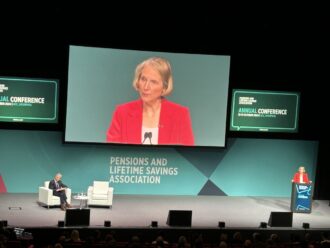The Society of Pension Professionals’ (SPP) Vision 2030 report for defined benefit (DB) pension schemes gives a detailed account of the dynamics that have shaped, and will continue to shape, the challenges such schemes face.
The report comes when many DB schemes are on track to achieve their endgame objective of self-sufficiency or an insurance buyout within 10 years.
Pension schemes have become the focus of intense scrutiny during the past 18 months, in the wake of the gilt market volatility of late 2022 and the Mansion House Reforms announced by Chancellor Jeremy Hunt in July.
A call for evidence from the government on options for DB schemes has sharpened the focus on their future further.
Indeed, it is against this backdrop that trustees face big questions about their investment strategy and how to achieve the best outcome for their members.
The report reveals that schemes are in much stronger funding positions and invested in lower-risk portfolios than they were 10 years ago. Unsurprisingly, schemes hold much larger collateral buffers following the gilt liquidity crisis. There is now a greater focus on building investment resilience, including avoiding being a forced seller of assets.
There is an emphasis on physical investment in gilts, and assets which offer contractual cashflows and a return over gilts, such as high-grade corporate debt, are likely to form the core of most schemes’ investment strategies going forward.
The resilience question
As a result of the crisis, many schemes have found themselves with a higher exposure to illiquid assets than they would normally have. Here the report asserts that resilience is not purely a question of asset allocation, and significant challenges remain that trustees need to consider.
The report also highlights the systemic risks associated with inflation hedging. “The inflation hedge of a scheme is imperfect because an RPI asset is used to hedge an inflation-linked liability, where the inflation linkage of the latter is limited by caps and floors,” says the report.
It also highlights how legislative, regulatory and tax framework adjustments following the Department for Work and Pensions’ (DWP) call for evidence, could impact how trustees view options before them – that is for schemes’ long-term investment strategies and endgame options.
In addition, the report gives a thumbs up and a nod to The Pension Regulator’s (TPR) subsequent guidance on the issue, which outlined what trustees should consider regarding liability-driven investment (LDI), which included the need for resilience testing, effective governance and resilience standards.
It noted, however, that since the revised code of practice on compliance with DWP’s draft regulations on DB scheme funding was first touted, changes in scheme circumstances have raised questions as to its applicability and relevance.
Here the Work and Pensions Select Committee has already asked TPR to postpone the launch of the code before the next general election – raising doubts about when, or if, it will be implemented in its current form.
Key changes
The report also identifies five key developments experienced by British final salary schemes.
One, most schemes (51%) were closed to new accrual in 2022, compared to 26% in 2012.
Two, most are paying out more than they receive, as they are no longer accumulating assets.
Three, the majority of pension scheme allocations are in bonds, not equities. DB schemes’ allocations to equities have almost halved from 53% in 2006 to 27% last year. At the same time, the allocation to bonds has more than doubled to 59% from 23%.
Four, liability hedge ratios have doubled. Data, including industry surveys, suggest the average liability hedge ratio for UK DB schemes has risen to more than 80% from 40%.
Five, funding ratios have improved substantially. Gilt yields fell between 2012 and 2022, but they have risen strongly since the beginning of last year. With the average scheme not fully hedged, this has improved many pension schemes’ funding levels.
This is clearly illustrated in the funding ratio of schemes eligible for the Pension Protection Fund soaring to more than 140%.
Funding levels
Against the backdrop of funding levels hitting their highest this century, and most pension funds closed to new members and largely closed to accrual, trustees are reconsidering their endgame targets, the report concludes.
As a result, a record-breaking amount of pension capital is expected to transfer to insurers over the next few years. But the report warned of “the systemic risks to which insurers are exposed,” which, has also been highlighted by regulators.
Commenting on the findings, SPP president Steve Hitchiner said: “The lifecycle of DB pension schemes has reached a critical tipping point. Schemes are, in general, continuing to mature and, following a decades-long battle against deficits, funding levels have improved with many schemes now finding themselves in surplus on a low-risk basis.”
For more on this paper, go here.





Comments